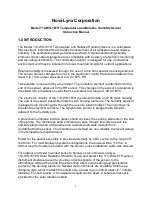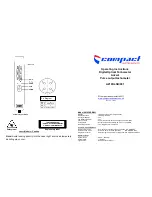
6
readings of the built-in thermometer. The chamber is a good test device to check to
overall operating range of the humidity sensor. Spot checking at ambient conditions
may not always detect a marginally defective sensing element.
4.3 Field Checking Temperature
Field testing of the temperature sensor can be performed using methods similar to
those used to test the humidity. As with the RH sensor, there are no user adjustments
available for the temperature sensing portion of the 110-WS-16TH.
If a psychrometer, such as the Assmann type, is used to check the humidity sensor, the
dry temperature thermometer can be used to verify the temperature readings of the
110-WS-16TH. The same is true of the electronic psychrometer, Model 225-HM34-C,
as it incorporates a direct reading thermometer.
Warning
: If it becomes necessary to perform an ice bath test of the 110-WS-16TH
temperature sensor, it is important to note that the sensor must be covered by a water
proof barrier in order to protect the RH sensing element. Placing the end of the sensor
into water with power applied will damage the RH sensor.
For both RH and temperature testing, it is important to remember to place the test
instrument sensing element into close proximity with the end of the 110-WS-16TH
sensor. If this task is difficult to accomplish due to site configuration, remove the
110-WS-16TH from its shield, and place it into an insulated box or bag alongside the
test instrument.
Return the sensor and mounting hardware to its original configuration upon completion
of the testing. Verify that the equipment is operating correctly before leaving the site.
5.0 MAINTENANCE
The Model 110-WS-16TH sensor assembly requires little or no maintenance. The only
recommended maintenance is a general cleaning of the outer case and routine testing
of the sensor’s operation.
Regular inspections of the sensor should be made to detect problems with the cable
and to prevent build-up of dirt, dust, and atmospheric pollutants.
Routine care and maintenance of the exterior of the instruments, housings, and shields
will increase the life of the equipment. Inspections of the fasteners and mounting
hardware should also be performed regularly. Look for loose or missing nuts and bolts
that may vibrate loose during high winds due to movement of the tower or mast.
For critical situations, NovaLynx recommends keeping spare sensors or sensor
components on hand for immediate replacement of the primary equipment should































